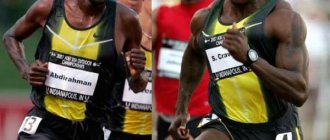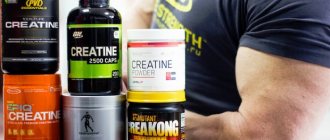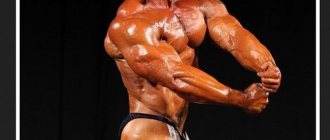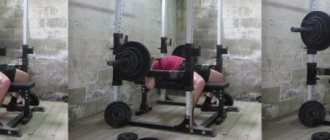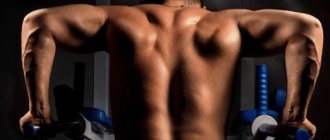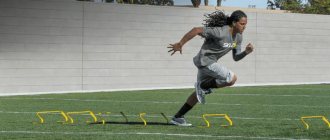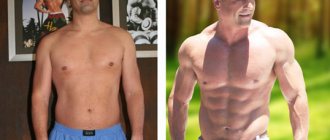Muscle hyperplasia[edit | edit code]
The difference between hypertrophy and hyperplasia
Hyperplasia
(Novolat. hyperplasia; other Greek. ὑπερ- - super- + πλάσις - formation, formation) - an increase in the number of structural elements of muscle tissue (muscle fibers) by dividing them. Unlike hyperplasia, hypertrophy involves an increase in the volume of cells and sarcoplasmic structures, without pronounced division (new formation of nuclei).
Research[1] confirms that the contribution of hyperplasia to muscle volume is less than 5% and is more significant only when using anabolic steroids. Myostatin blockers can also cause hyperplasia. Growth hormone does not cause hyperplasia.
People prone to hypertrophy usually have a larger number of muscle fibers. The total number of fibers is determined genetically and practically does not change throughout life without the use of special pharmacology. There has been no evidence of an increase in the number of muscle fibers (muscle fiber hyperplasia) in humans under the influence of strength training, although muscle fiber hyperplasia is possible in animals (mammals and birds)[2].
Research[edit | edit code]
While during muscle hypertrophy an increase in the number of nuclei in a muscle cell is observed, in animal studies of atrophy processes the opposite phenomenon was noted. A decrease in the number of nuclei occurs as a result of atrophy of muscle fibers after transection of the spinal cord [3], during prolonged stay in conditions of weightlessness [4] or temporary immobilization of the hind limb [5]. Thus, changes in the number of nuclei per muscle cell appear to be of great importance in regulating cellular fibril size. At the same time, it must be borne in mind that an increase in the number of nuclei in a muscle fiber will occur as long as the activity of converting existing nuclei is capable of ensuring an increase in their number. Indeed, noticeable changes in the number of nuclei in the muscle fiber were observed in muscles hypertrophied by more than 26%[6], but not in muscles hypertrophied by 6.8-15.5%[7].
Since differentiated muscle fiber nuclei are unable to divide, the main source of new nuclei in hypertrophied muscle fibers are myosatellite cells or satellite cells[8]. Myosatellitocytes are located between the basal plate and the plasma membrane of muscle fibers[9], they are characterized by a high nuclear-cytoplasmic ratio, a well-developed Golgi apparatus, a pronounced granular endoplasmic reticulum and a heterochromatinized nucleus[10]. Activation of satellite cells can occur under the influence of a number of stimuli, after which they begin to actively divide. After this, the daughter cells formed as a result of mitosis merge with nearby differentiated muscle cells, thus providing an increase in the number of nuclei. The role of the nuclei formed during the division of myosatellite cells in the process of muscle hypertrophy is also confirmed by experiments on animal models demonstrating that activation and subsequent proliferation of satellite cells are necessary to ensure muscle growth [11].
It has been shown that, in parallel with muscle hypertrophy, intense strength training induces a significant increase in the number of satellite cells in skeletal muscles[12]. A 46% increase in the proportion of myosatellite cells in the skeletal muscle of a young woman was reported after 10 weeks of resistance training[13]. Recently, an increase in the number of myosatellite cells was found in the skeletal muscles of a group of men aged 70–80 years who were engaged in endurance training[14]. Thus, satellite cells ensure an increase in the number of nuclei in the muscle fiber and the renewal of their own pool [15]. Newly formed muscle fibers replace damaged ones or contribute to muscle fiber hyperplasia only if the number of newly formed fibers exceeds the number of fibers damaged during exercise.
What is sarcoplasmic reticulum?
This is the name given to the membrane network of muscle cells, which is similar to the endoplasmic reticulum of other cells. In simple terms, the sarcoplasmic reticulum (hereinafter simply SR) of a muscle fiber is a network of tubes that stretch and wrap around cells, but do not contact them directly.
The main task of SR is the accumulation of calcium ions. Their content in the cells should be approximately the same amount, although the concentration of calcium in the cells is maintained thousands of times lower compared to the extracellular space.
Hypertrophy or hyperplasia?[edit | edit code]
Source
: Iron World. No. 6.2013
What is the reason for the growth of muscle mass, hypertrophy of muscle fibers (an increase in the volume of muscle fibers), or their hyperplasia (an increase in the number of muscle fibers)? Official science does not confirm the data on the possibility of CF hyperplasia in humans, although there are quite a lot of facts confirming the presence of this process in animals. In recent years, however, works have begun to be published frequently that question the official point of view.
Supporters of CF hyperplasia were supported by such a well-known and deservedly respected specialist in power sports as Mikhail Klestov, well known to readers of our magazine:
- The limit to the possibility of hypertrophy
is doubling the diameter of the muscle fiber. The most massive athletes have muscle fibers no more than 2 times thicker than those of the leanest dystrophic person. Further progress is possible only due to hyperplasia. The muscle spindle can increase its diameter by a maximum of two times. This is due, among other things, to problems of a trophic nature. At least, science does not know a single fact that a muscle spindle is three times larger than the average diameter. A maximum twofold increase in diameter was observed. However, among the pros there are many athletes who have increased their muscle mass three times or more.”
Very logical, isn't it? But only if you don’t doubt the original data. Unfortunately, I have too often witnessed the extreme inertia reigning in science. For example, an important discovery has been made in the field of physiology, which allows us to completely rethink and change the existing stereotype in training. Do you think everyone will start making adjustments right away? No. Firstly, in order for people to know about this information, they need to invest huge amounts of money in its promotion. Scientists themselves do not do this; their job is scientific work. If a brilliant discovery does not immediately bring huge dividends, then there are not many people willing to spread information about it or somehow promote it. Moreover, it is often met with hostility. About fifteen years ago, at the Research Institute of Fundamental and Applied Problems of Physical Education and Sports, the possibility of local fat burning was irrefutably proven. Proven, scientifically substantiated and confirmed by a huge amount of statistical material. All this was published in scientific publications, but the inertia of science is such that even now at training courses for fitness trainers and seminars they continue to repeat the impossibility of local fat burning. The indications of such types of testing as body mass index (BMI) and the Karvonen test have long been considered unscientific and false, but, nevertheless, they are stubbornly implanted in all fitness centers.
Unfortunately, in our country we do not have a service that would monitor all serious scientific discoveries published in scientific journals and introduce our specialists to these discoveries. Therefore, we decided to turn to Professor Viktor Nikolaevich Seluyanov for clarification on this issue, who has been studying and analyzing all the major scientific periodicals in the world for several decades.
Iron World
: Viktor Nikolaevich, what is the main cause of muscle growth, hypertrophy or hyperplasia of muscle fibers? Has there been any research done in the world that remains unknown to our coaches and strength training specialists?
Victor Seluyanov
: In the 70-80s, the question arose of what causes muscle growth in athletes, especially bodybuilders. Then they took biopsies from athletes, and indeed it turned out that the cross-sectional size of the muscle fiber in bodybuilders was only 30% larger than in ordinary people. And the appearance of an ordinary person and a bodybuilder differs significantly. 3, and maybe 4 times. Therefore, they began to look for the reasons why such muscle growth is possible. In the USSR you can find such an author as Druzd, who began to study the muscles of trained people using biopsies and in the end he found that large muscle fibers can divide. The so-called longitudinal division occurs in them, which is possible; in addition to increasing the size of the muscle fiber, some laws arise according to which their bifurcation occurs. Thus, the number of muscle fibers increases. At the same time, there was no talk about myosatellites. By the way, myosatellites still belong to an unknown area of knowledge. It is still believed that myosatellites do not participate in CF hypertrophy, that is, new fibers are not formed due to myosatellites. Although now they are trying to influence them with the help of pharmacology and thus increase muscle volume, we will assume that this is still a hypothetical area. Time has passed. More and more biopsy samples were taken from athletes of varying fitness levels. If previously it was believed that only 30% of the fibers could be hypertrophied, then subsequent studies showed that the size of the muscle fiber can be increased by 3-4-6 times or more! And the factor of the possibility of CF hyperplasia moved aside. Today we can clearly say that the number of muscle fibers in a person is set from birth. If one person grows muscles quickly, it is not because the amount of MV increases in him, but he initially had a lot of MV, and another, even if he wants to, will not be able to build up large muscle mass, because he initially has little MV.
ZhM
: But if he can increase their diameter by 6 times.
Victor Seluyanov
: Yes, it can increase, but it cannot reach a high level in bodybuilding. He will still lose to an opponent who has 3 times more muscle fibers. In speed skating, for example, the prospects of an athlete are determined by the size of the quadriceps femoris muscle. If this muscle is not large from birth, then he will not get good results in skating. And if it is initially large, then in a year or two he is able to fulfill the MS standard. There are many such cases. One of the most famous is speed skater Oleg Goncharenko. In two years of training he became a world champion. But he came with huge legs.
ZhM
: So, you completely deny the possibility of CF hyperplasia?
Victor Seluyanov
: Perhaps this factor exists. I think up to 3% muscle fiber can be added. One can agree with Druzd regarding longitudinal splitting. But no one has yet proven that CF hyperplasia can be a significant factor in increasing muscle size, increasing muscle strength, and increasing athletic performance.
ZhM
: There has been an opinion in bodybuilding for many years that CF hyperplasia is promoted by taking growth hormone.
Victor Seluyanov
: No, growth hormone, of course, does not work to increase the amount of CF. It enters cells, affects DNA, and in cells it begins to more actively build components responsible for its strength. It is especially active in tendons, ligaments, and places of attachment of muscle tissue to the tendon. Some muscle tissue also grows. Myofibril hyperplasia occurs in the muscle fiber. That's all that is currently known about the anabolic effect of growth hormone, and the rest is more fiction than scientifically explainable facts.
ZhM
: If in the late 80s - 90s studies were already carried out that proved the possibility of increasing the diameter of MVs by 6 or more times, why is there no such data in the domestic literature? And it is still stubbornly said that it is impossible to increase MV by more than 2 times
Victor Seluyanov
: Perhaps because there are not many such articles and such studies in the world. I know of 3-4 articles with similar studies. To do this, it is necessary to constantly monitor all published scientific literature in order to select 1-2 out of 1000 articles on the topic of interest, which were written at a high scientific level and on a contingent of high-class athletes. Now I will introduce you to one of the very worthy works published back in 1989. It has never been translated into Russian, my translation.
Comparative analysis of muscle fibers of elite male and female bodybuilders
[16]
The problem of the degree of hypertrophy of muscle fibers was studied on highly qualified bodybuilders. There were 8 men and 5 women. The average anthropometric indicators were 173 cm, 87 kg and 166 cm and 62 kg, respectively.
The subjects of the study were the elbow flexors, long head of the biceps brachii and brachialis. A biopsy was taken from these muscles. The tissue sample was frozen in liquid nitrogen. Muscle composition was determined according to Bergstrom. Myosin ATPase activity was assessed. The cross-section of muscle fibers was measured under a microscope (x15000). The total muscle area was measured from a photograph of a muscle section after computed tomography. The amount of MV in the muscle was determined by dividing the muscle area by the cross section of the average muscle fiber.
As a result, the share of type 2 CF (fast) was around 50%. The share of the non-contractile part was 9-10%. The average cross-sectional area was 7,200 mm2 and 4,700 mm2 for type 1, 11,400 mm2 and 5,000 mm2 for type 2 in men and women, respectively. Of particular interest are data on the cross-sectional distribution of muscle fibers. In Fig. it can be seen that the size of muscle fibers ranges from 2000mm2 to 15000mm2 in women and up to 20000mm2 in men. The shoulder girth for men was 47 cm; if we recalculate, taking into account the reduction in the cross section of the MV to the norm of an untrained person (3000-4000 mm2), then the shoulder girth will be 27-30 cm. Consequently, in bodybuilders, muscle mass growth was associated only with MF hypertrophy (myofibril hyperplasia). “There is no room left for hyperplasia of muscle fibers.”
Event frequency by area
Comments
:
The non-contractile part of the CF, that is, the non-contractile part. This is what enters the muscle cell in addition to myofibrils. This includes mitochondria, sarcoplasmic reticullum, etc. Sometimes they talk about mitochondrial and sarcoplasmic muscle hypertrophy. So they fit into this 9-10%. When professional histologists hear about these types of hypertrophies to increase muscle mass and about special training aimed at this, they start laughing. Their contribution to muscle growth can be so insignificant.
It turned out that the average cross-sectional area of elite bodybuilders in a BMW is 11,400 mm2, which exceeds the average of an untrained person (3000-4000 mm2) by 2.85-3.8 times, and in absolute values, as can be seen from the curve in the graph, The cross-sectional area of fast muscle fibers in men can exceed 20,000 mm2, which is 5 - 6.5 times higher than the average for an untrained person.
Two types of muscle fibers
Let's discuss what science knows for sure.
Muscle tissue is a complex structure made up of bundles of long, elongated cells (called fibres). They are wrapped in dense connective tissue - perimysium. This is what it looks like:
There are two types of fibers:
Type 1 - slow muscle fibers. They have a lot of capillaries, mitochondria and myoglobin, which, as a result, makes them resistant to fatigue (fatigue). At the same time, they practically do not grow, and their strength almost does not increase.
Type 2 - Known as fast twitch muscle fibers. They grow and contract faster, which gives them significantly greater potential for strength and energy. Their big “disadvantage” is that they get tired much faster. Therefore, they are not suitable for endurance exercise.
Different muscles in our body have different ratios of type 1 and type 2 fibers. Science does not know exactly what this distribution depends on. The question is why some people have more type 1 fibers than type 2, and vice versa.
Most likely, genetics are to blame for everything. Because numerous studies have shown that training cannot convert one type of fiber into another.
For example, there is no difference in the ratio of muscle fibers between completely untrained people and professional athletes.
But there is a lot of evidence that different types of loads have different effects on fibers:
- training with low weight and high repetitions preferentially stimulates type 1 fibers;
- training with high weights and low repetitions is the second type.
This explains why training with heavy weights (80% of one-rep max) is most effective for gaining muscle mass.
The study was carried out:
34 physically active men were divided into 2 groups.
- Group 1 trained with a high number of repetitions - 4 workouts per week, consisting of 4 sets of each exercise of 10-12 repetitions (70% of the one-rep maximum).
- Group 2 trained with a moderate number of repetitions and high intensity. 4 workouts per week, 4 sets of each exercise. 3-5 reps per set (90% of one-rep max).
Both groups performed the same exercises. Which included:
- bench press;
- deadlift;
- squats;
- seated military press.
They all followed a similar diet.
What was the result? After eight weeks of training, the group that trained with heavier weights had gains in muscle mass and strength that were significantly greater than those of the higher-repetition group.
The main reasons why training with heavier weights is more effective than training with lighter weights:
- Greater mechanical force. On the other hand, high-repetition training causes greater metabolic stress.
- Activation of muscle fibers is more pronounced. Inclusion of a larger percentage of muscle tissue in the process.
Sources[edit | edit code]
- Kraemer, William J.; Zatsiorsky, Vladimir M. (2006). Science and practice of strength training. Champaign, IL: Human Kinetics. p. 50. ISBN 0-7360-5628-9.
- MacDougall JD Hypertrophy and Hyperplasia // In: The Encyclopedia of Sport Medicine. Strength and Power in Sport. - Bodmin, Cornwall: Blackwell Publishing, 2003.
- Allen et al., 1995
- Allen et al., 1996
- Hikida et al., 1997
- Cabric, James, 1983; Allen et al., 1995; Roy et al., 1999; Kadi, Torncll, 2000
- Giddings, Gonyea, 1992
- Moss, Lcblond, 1971; Schiaffino et al., 1976
- Mauro, 1961
- Campion, 1984
- Rosenblatt, Parry, 1992; Rosenblatt et al., 1994
- Kadi, 2000; Roth et al., 2001
- Kadi, Tomell, 2000
- Charifi et al., 2003a
- Bischoff, 1994; Schultz and McCormick, 1994; Kennedy et al., 1988; Yamada et al., 1989; McCormick and Schultz, 1992; Antonio, Gonyea, 1993; Kadi, Thomell, 1999
- S. E. Alway, W. H. Grumbt, W. J. Gonyea, and J. Stray-Gundersen Contrasts in muscle and myofibers of elite male and female bodybuilders J Appl Physiol July 1, 1989 67:(1) 24-31
Sarcoplasmic hypertrophy
Sarcoplasm is the fluid that surrounds myofibrils in muscles and is a source of energy. It contains such “things” as ATP, glycogen, creatine phosphate and water.
Sarcoplasmic hypertrophy generally occurs in the same way as myofibrillar hypertrophy. The body, during the recovery period after the depletion of your energy reserves, “compensates with a reserve” for what was lost. Thus, the amount of energy reserves - such as ATP and glycogen - is increased in order to subsequently prevent their rapid depletion.
An increase in the size of the blood vessels that "deliver" blood to the muscles can also be included in sarcoplasmic hypertrophy. This phenomenon is often called capillarization.
So now you know the two types of hypertrophy. What's the best way to achieve both of them? Before answering this question, I would like to emphasize: match the weights to the number of repetitions, NOT the number of repetitions to the weights.
Progressive overload means gradually increasing the load on the muscle as it becomes stronger or more resilient. This means that you need to use weights and repetitions that will be very difficult to overcome.
You need to choose exactly the weight with which you can barely do the required number of repetitions. Do not take weights with which you cannot do the required number of repetitions or, conversely, at the end of the set you will be able to do many more repetitions. Therefore, if you need to do 12 repetitions in an exercise, choose a weight with which you can do exactly 12 repetitions.
Myofibrillar hypertrophy
Myofibrils are muscle fibers collected in bundles (myofilaments) that contract muscles and generate tension in them. Myofibrils are the basis of any muscle tissue in the body.
Myofibrillar hypertrophy occurs due to overstimulation of muscles (by lifting more weight than the body is accustomed to) and microtrauma to individual muscle fibers. By restoring microtraumas at the muscle fiber level, our body increases the density and volume of myofibrils to prevent similar injuries in the future.
This is why muscles need to be overloaded to achieve success.
Cancer connection
No matter how sad it may sound, tissue hyperplasia, if this is not an action controlled by the athlete, is often a harbinger of serious disorders of the body. The problem is that cancer cells are formed according to a similar principle - this is nothing more than the hypertrophy of individual tissues (brain, bone, immune, etc.), which gradually tears the cell itself from the inside, and the body’s desire for super-recovery creates a new nucleus for the torn cell.
The only differences are in the causes of hypertrophy. If hyperplasia of muscle tissue requires a huge number of supporting factors and, as soon as at least one of them disappears, hyperplasia will stop, then cancerous tumors are a consequence of metabolic disorders in the body, often at the genetic level, and in this case tissue hyperplasia occurs uncontrollably , constantly increasing in pace.
However, do not be afraid: artificial hyperplasia of muscle fibers will not lead to cancer under any circumstances.
Training for sarcoplasmic hypertrophy
Sarcoplasmic hypertrophy is achieved through so-called endurance training. The weights taken are approximately 75% of those that you can do at one time, and the number of repetitions is 10-15. The pause between sets is 45-90 seconds. This is called endurance training because it uses up large amounts of energy in the muscle cells very quickly, depleting the muscles.
When choosing the number of sets for such workouts, you need to take into account the amount of time spent under load. There is a minimum amount of time that must be spent under load to achieve hypertrophy. And for endurance training this time is longer than for strength training.
In endurance training, the time under tension should be greater than the reserves of energy available for expenditure. The main sources of energy for anaerobic exercise are ATP and creatine phosphate. They are short-lived and deplete after 7-10 seconds. After this, your body resorts to glycogen stores, which in turn causes the release of lactic acid (this is what causes a burning sensation in the muscles). This means that in endurance training, the time under load should exceed 10 seconds. This in turn means that performing slow reps and supersets is a great way to achieve sarcoplasmic hypertrophy.
